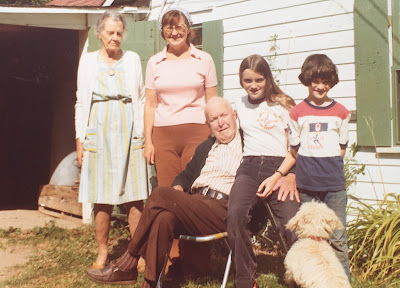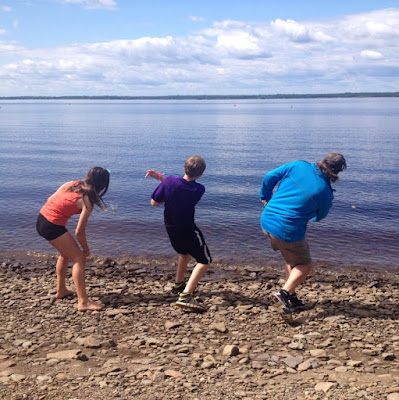You know your bathroom is disgusting when your neighbour's daughter, who has autism, will not pee in your toilet. But I have discovered a strategy that helps me overcome the shame, and let's me tackle the housework without resentment.
By the way, to figure out how to get this toilet bowl clean I had to watch alot of Kim and Aggie of the British show "How Clean is Your House?" The secret was a pumice stone that could scrub the stains off the porcelain without scratching it - who knew?!!
I hope that I have previously established that I am not a hoarder. And I'm not a hoarder in denial - really! But I do have a problem with STUFF! Sorting stuff, putting away stuff, and cleaning stuff. And, with five years of poor health, things had really piled up, literally and figuratively. When you deal with depression, tasks that are routine for most people can feel overwhelming – washing the dishes, doing the laundry, opening the mail, filing papers, or... cleaning the bathroom.
When I would look around me and see all the stuff that I had failed to do, I would beat myself up for letting this happen, worry that I would never get it all done, feel guilty and overwhelmed, and stick my head back in that hole in the ground. I believe it's called denial. (Remember, one of the ways to get your head out of the ground is to dig your way out like the dung beetle or scarab.) When I recognized how difficult it was to get on top of the housework, I used one of my first knock-off beads to remind me of the importance of creating a home that is comfortable, safe, and peaceful. I later replaced this with the Pandora Hopi charm on my "Lucerne Recovery" bracelet.
 |
| The "Before" |
When I would look around me and see all the stuff that I had failed to do, I would beat myself up for letting this happen, worry that I would never get it all done, feel guilty and overwhelmed, and stick my head back in that hole in the ground. I believe it's called denial. (Remember, one of the ways to get your head out of the ground is to dig your way out like the dung beetle or scarab.) When I recognized how difficult it was to get on top of the housework, I used one of my first knock-off beads to remind me of the importance of creating a home that is comfortable, safe, and peaceful. I later replaced this with the Pandora Hopi charm on my "Lucerne Recovery" bracelet.
 |
| The Hopi charm, to the right of the tulip with the dangle |

When I first started this journey of recovery with Pandora, I wanted this Hopi charm because it reminded me of my grandmother Holmes, or "Granny" as we called her. She spent her winters in Arizona and had a string of silver beads that I loved, made by the expert silversmiths of the Native-American Hopi. As I shared in a previous post about her, she always liked to show me her jewellery and tell me stories of the places she'd visited in the world, where the jewellery was from.
Oh, I just realized something! She started me on this journey of having jewellery for "unforgettable moments," as Pandora calls them. I don't know who inherited those beads, so for now, in addition to the Hopi bead, I have some earrings in that style and a turquoise Mii bracelet.
But I digress. When I looked into "Hopi," I discovered that there was another reason for me to have this charm.
The word "Hopi" means "behaving one," one who is mannered, civilized, peaceable, polite, who adheres to the "Hopi Way." Wikipedia describes the Hopi Way as "a concept deeply rooted in the culture's religion, spirituality, and its view of morality and ethics. To 'be Hopi' is to strive toward this concept, a state of reverence and respect for all things, to be at peace with these things, and to live in accordance with the instructions of the Creator or Caretaker of the Earth." For the Hopi, all of daily life is part of their religion, and their belief is to help others improve their lives.
When I started to dig out of this disorganized and dirty mess a few years ago, I tried making schedules for myself. In my agenda I would put "Paid" and "Unpaid" work, which of course I then resented. Then I scheduled time for "chores," which of course made them feel like... well... a chore. So now I schedule time to do things that are "Done with Love." It's similar to when someone really bothers you, and instead of cursing them, you bless them. So I started with a daily "Bless This Kitchen" and then moved on to a weekly "Bless This Bathroom." It really does change your outlook and attitude.
 |
| My typical morning, the blue representing self-care |
Rather than beat myself up, and get anxious or overwhelmed, the Hopi charm reminds me to "practice the religion of daily life and be at peace with things." Or, to keep the affirmation shorter, I say "Don't Worry, be Hopi." (You have to watch the video so you can use the correct accent when you say it.)
YouTube video of Bobby McFerrin's "Don't Worry, Be Happy"
Seems appropriate that the late Robin Williams is in this video
 |
| photo credit Taylor Hayden |
In her book "Simple Abundance: a daybook of comfort and joy," (which I mentioned in a previous post about gratitude) author Sara Ban Breathnach says, "The Quakers, or members of the Religious Society of Friends... refuse to segment their lives into the Sacred and the secular. Quakers believe that all of life's daily experiences are spiritual in nature, from preparing a family meal to protesting political policy." She quotes the British writer George Gorman who observed that "the essence of Quaker spirituality is the certainty that everything we do has religious significance. It is not cutting ourselves off from life but entering deeply and fully into it."
This is similar to the practice of Mindfulness, which can be described as "paying attention on purpose." Practicing mindfulness of daily living is to do each thing with all of your attention, intentionally bringing your mind to the present, even if that "present" is the enviable job of cleaning the toilet.
I have the "Bless This House" charm sitting in my jewellery box, waiting until we complete the Clean Sweep of the whole house. The charm will require, quite fittingly, a lick and a polish before I can add it to my all-silver timebead bracelet.
I am pleased to say that we now "Bless This Bathroom" every week, each of the four of us with a different task (as well as other non-bathroom jobs) as part of our "Saturday chores." We are now in the maintenance phase! And Yes, it's me that does the toilet - and nobody is afraid to pee in it!
 |
| What I wear with my Lucerne Recovery bracelet |
Related Posts:
Clean up with the tea cup - a story about the start of the Clean Sweep, with "Before" and "After" photos of our sunporch, and my most important affirmation in dealing with negative self-talk about the state of our home - and the charm to represent it.
Bellies and babies and "girlie parts" - a story about one of the reasons our house got so messy, the health problems I battled, including those things that women just don't talk about - and the charm to represent it.
My Pandora journey of recovery - how it all began - a story about my first knock-off charms, how I use charms as rewards, and how charms help me in my recovery.
You can search the blog, at the bottom of the website version, using key words. You can also see all of the stories about the charms from my first bracelet by clicking on the label for "Lucerne Recovery bracelet."
Photo Gallery
 |
| The "Before" |
 |
| The "After" |
 |
| The "After" |
 |
| shower curtain rings to match the handles on the sink faucets |
 |
| a clean bathroom with a drawer unit under the sink for supplies and toiletries a garbage AND recycling bin to keep the toilet paper rolls off the floor |
 |
| this angel ornaments was the inspiration for the bathroom colours |
 |
| Martha Stewart curtains in the colour scheme of sage green and lilac |
 |
| an antique plate of my mom's with purple violets |
 |
| A Wedgwood sage green "Jasperware" plate from my in-laws |
 |
| original hexagonal bathroom tiles |
 |
| a new white shower curtain as a reward for cleaning the bathroom |
 |
| IKEA's brilliant solution to the tub mat that would always fall off the edge of the tub, drip onto the floor, or stay down in the tub and get mouldy |
 |
| a tray for the back of the toilet for candle holders and Kleenex |
 |
| a few purple accents on shelves above the toilet |
 |
| The "After" |













































